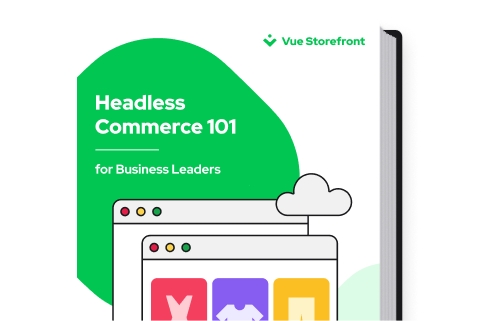Explore by Category:
Headless Commerce
Uncovering the Latest Headless Commerce Statistics for 2023
Are you considering going headless? This piece will let you brush up on the most relevant headless commerce statistics for 2023.
What is headless commerce?
Headless commerce is the commonly used term for decoupled commerce software architecture, in which the system's frontend layer is separated from the backend business logic.
It is a component of the method in which an eCommerce platform, CMS, and other third-party tools such as payment solutions, analytics tools, loyalty programs, and search engine solutions connect via API-first logic. This makes the entire eCommerce software work in a fast and flexible way.
Read more about the benefits of headless commerce .
Headless Commerce statistics that you need to know
Headless Commerce getting $1.6 billion in funding
Funding for headless commerce platforms has increased as investors see these technologies' potential to shape eCommerce's future. Headless CMS systems (complementing headless platforms) also enjoy fast investment growth. According to Forbes, over $1.65 billion in financing has been obtained for headless technology in 2020–2021 alone, and we are yet to learn about the amount raised in 2022.
74% of organizations recognize that failure to adopt emerging commerce solutions will negatively impact areas of their business
Businesses today are operating in an increasingly competitive digital landscape. To remain competitive, they need to stay up to date with the latest developments in eCommerce solutions. In a recent commerce innovation report by commercetools nearly three quarters ( 74% ) of the respondents acknowledged that failing to take advantage of the latest eCommerce technologies will have a detrimental effect on various aspects of their business. Brands need to be nimble and meet customers where they are. This means having a finger on the pulse of their customers’ shopping behaviors.
On average, organizations spend $2.6 million for implementing headless architecture
Organizations have made, and are ready to make, a significant investment in headless computing. On average, respondents' firms spent $2.6 million implementing headless architecture , a figure sure to rise as more adopters and vendors enter the headless field.
While encouraging, this eagerness to invest in headless also speaks to the need for headless solutions to deliver on the promise of faster, more powerful digital experiences and streamlined agile workflows. With higher investment comes the challenge of higher ROI, and only through well-designed, optimized headless solutions will higher ROI be genuinely attainable.
80% of businesses that don’t have headless architecture today say they plan to implement it in the next two years
Headless commerce technology is not only advantageous to tech teams, but to the entire business in general. This can provide a much quicker way of operating in terms of marketing, customer service, and store operations.
The State of Commerce report, by Salesforce, found that 80% of companies that do not have headless architecture are planning to do so in the following two years. If you are uncertain if headless is right for you and your business, consider whether it will help address issues experienced by customers now and in the near future.
77% of organizations with headless architecture say it enables faster changes to storefronts
Because customer preferences, market trends, and business needs evolve rapidly, agility is essential for success. When it comes to online stores, it's important to avoid creating a time-consuming bottleneck. A clumsy backend experience can have an adverse effect on both the productivity of your teams and the customer experience.
Fortunately, headless commerce reduces the time needed for changes, which may have previously taken days or weeks, to just a few hours. Again, according to the State of Commerce report , 77% of organizations who use a headless architecture state that it gives them greater agility, allowing them to make changes to their storefront more quickly.
This approach makes it easier to nimbly respond to changing consumer behavior and expectations. This is also backed up by data, as companies with a headless commerce architecture report that they can expand into new channels at a faster rate.
Organizations which embraced a composable approach will beat the competition in terms of new feature implementation speed by 80% by 2023
Businesses are using composable commerce to design and deliver various experiences. COVID-19 served as a wake-up call for many companies regarding proper scalability. It also sparked a more in-depth investigation into the lost expenditures of underutilized features and delayed update turnaround times.
The Gartner research points out that organizations which embraced a composable approach will beat the competition in terms of new feature implementation speed by 80% by 2023. Because of its versatility, composable commerce has begun to appear on the radar of commerce firms.
Headless commerce is gaining momentum. 34% of organizations say it takes weeks or months to make changes to their digital storefront
The time it takes to implement changes to a digital storefront can have a major impact on a company’s bottom line. According to a report from Salesforce, 34% of organizations say it takes weeks or months to make changes to their digital storefront.
Time is of the essence when it comes to making changes to a digital storefront. Businesses must be able to quickly adapt to the latest trends and customer preferences. If changes take too long to implement, competitors can easily overtake the organization in terms of market share. It is also important that changes are made quickly to ensure customers receive the best service and can access new products and services as soon as they become available.
Other interesting statistics
Below are some more highlights from the State of Commerce report by Salesforce. They surveyed 4,000+ commerce leaders and analyzed data from 1B+ buyers worldwide. See the reported benefits of headless commerce and what these insights mean for your business.
- 76% of respondents agreed that headless commerce allows for more flexibility, and the ability to customize digital experiences
- 72% voted that it also increases agility and gives the opportunity to make changes faster
- 57% of leaders from all business sizes say that they plan to implement headless in the next two years
- 69% acknowledged that it gives the ability to add new sales channels (social, voice, AR, VR)
- 66% said that improved integration between systems
In this innovation report by commercetools, we can also observe some key findings taken from a 2022 survey of 300 global business decision-makers.
- More than two-thirds of respondents (68%) say it takes their company three months or longer to take new commerce solutions to market.
- Half of respondents (50%) report that their own reservations about their organization’s technologies have limited their company’s ability to innovate as quickly as needed.
- Almost three-quarters of respondents (73%) say it’s likely or very likely they’ll take their business as a consumer elsewhere when a brand doesn’t have the shopping experience they expect.
- Over a third of respondents (36%) say they feel jealous of competitors’ commerce offerings. Among those who feel jealous, the majority (61%) say it’s because of how quickly their competitors can introduce new offerings.
- Almost half of respondents (45%) said only a minimal amount of their annual budget is dedicated to improving or expanding commerce capabilities.
This Magic Quadrant for Digital Commerce by Gartner evaluates 18 vendors of digital commerce platforms to assist application leaders take well-informed decisions. Here are some of the strategic planning assumptions:
- By 2023, prices for B2C digital commerce platforms will be 30% less than in 2019, due to feature commoditization and “headless” implementations.
- By 2024, 15% of B2B organizations will use digital commerce platforms to support both customers and sales reps in all sales activities.
- By 2024, 10% of digital commerce organizations will use packaged business capabilities to construct their application experiences.
- By 2024, the IT costs of managing SaaS operations will be halved as a result of the adoption of composable application architectures.
- By 2025, organizations offering a unified commerce experience by frictionlessly moving customers through journeys will see at least a 20% uplift in total revenue.
Final thoughts
As the era of the digital revolution continues, headless commerce is a great option. Headless commerce solutions provide the capabilities required for consistent development. Simultaneously, it assures that the brands will survive in an ever-changing commercial environment. Read more about the benefits of headless commerce .
Share:
Share:
More in Headless Commerce
Ready to dive in? Schedule a demo
Get a live, personalised demo with one of our awesome product specialists.






















